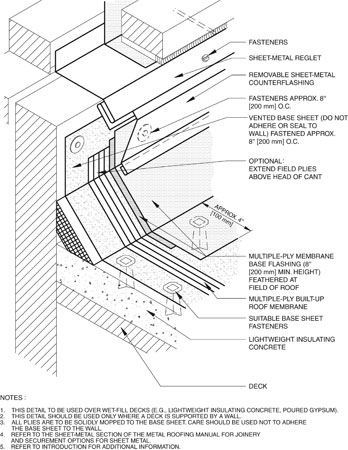An important but less commonly used detail in the roofing industry is for proper installation of base flashing with a new lightweight insulating concrete (LWIC) or poured gypsum roof deck. The NRCA Roofing and Waterproofing Manual, Fifth Edition, provides a detail for installation of a built-up roof system's base flashing where a wall meets an LWIC or poured gypsum deck in BUR-5A, "Base flashing for vented base sheet."
The unique and critical element of the detail is proper installation of the vented base sheet horizontally under the membrane and vertically behind the base flashing. The purpose of the vented base sheet is to facilitate venting and drying of residual moisture vapor (generally not liquid moisture) from the hydration process of an LWIC or poured gypsum roof deck. A roof assembly that incorporates LWIC or poured gypsum needs to be detailed and constructed to allow moisture to travel horizontally in the roof's field and vertically at base flashings; therefore, a vented base sheet cannot be fully adhered to a deck. NRCA recommends a vented base sheet be mechanically attached to an LWIC or poured gypsum roof deck with suitable fasteners.
Even though NRCA recommends LWIC and poured gypsum decks be vented from the underside—through slotted metal form decks or permeable form boards—edge details that allow venting should be installed to allow top side venting of excess moisture. The primary method of venting an LWIC or poured gypsum deck is to provide ventilation from the underside. Therefore, adequate interior ventilation should be provided below a deck to remove excess moisture from an LWIC or poured gypsum deck. Lateral and vertical venting become even more critical when LWIC is installed over nonvented substrates, such as structural concrete.

Detail BUR-5A from The NRCA Roofing and Waterproofing Manual, Fifth Edition
BUR-5A allows some moisture to be vented through perimeter openings. Proper installation of metal edge counterflashing is critical to prevent moisture from getting behind the mechanically attached base flashing. Other details, such as gravel stop edge metal, also should provide top side venting and are available from manufacturers.
James R. Kirby, AIA, is an NRCA senior director of technical services.
COMMENTS
Be the first to comment. Please log in to leave a comment.